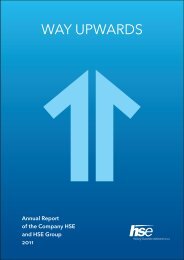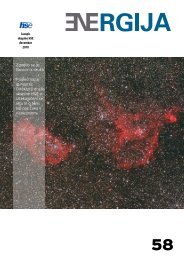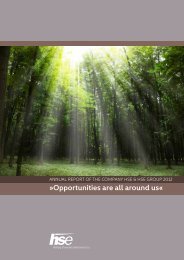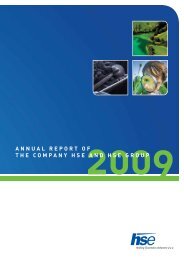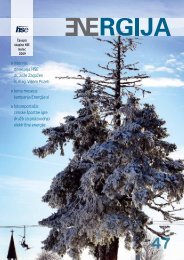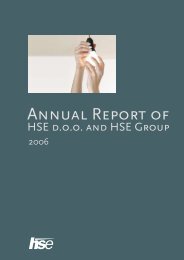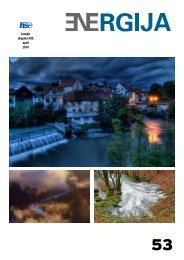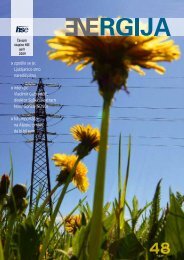ANNUAL REPORT - HSE
ANNUAL REPORT - HSE
ANNUAL REPORT - HSE
Create successful ePaper yourself
Turn your PDF publications into a flip-book with our unique Google optimized e-Paper software.
3.2 Responsibility<br />
to the natural<br />
environment<br />
Environment-friendly<br />
Slovenia entered the EU with a comparatively well preserved<br />
natural environment and with the awareness that<br />
the environment is one of the pillars of future sustainable<br />
development.<br />
The <strong>HSE</strong> Group designed its environmental policy at the<br />
very beginning of its operations. Its basic components<br />
can be summarised as follows:<br />
• to produce electricity with a minimum impact on the<br />
environment,<br />
• to observe all legal standards and recommendations,<br />
• to introduce the best technologies available in order to<br />
minimise the impact on the environment,<br />
• to promote the development of RES,<br />
• to achieve a partnership with local communities and<br />
jointly solve environmental issues and plan for the sustainable<br />
development of electricity production,<br />
• to achieve sustainable operation and development of<br />
energy capacities.<br />
of RES is developing quickly in Slovenia. Under the<br />
Slovene Energy Act, renewable energy sources are the<br />
sources that are entirely or predominantly renewable<br />
in the natural environment. These primarily include hydropower,<br />
wind, biomass, geothermal and unaccumulated<br />
solar energy. The Act is based on guidelines from<br />
EU directives, and being an EU member state Slovenia<br />
is obliged to increase the use of E-RES from 29.9% in<br />
1999 to 33.6% until 2010. In December 2008, the final<br />
text of the new EU directive on RES was adopted. The<br />
directive prescribes for each EU country a general goal<br />
regarding the share of RES in the ultimate energy consumption<br />
for the year 2020. For Slovenia, this share<br />
amounts to 25%.<br />
In terms of volume, energy from hydropower plants is<br />
the most important source of electricity from renewable<br />
sources in Slovenia. The area of renewable energy<br />
sources is therefore highly important, both for the<br />
operation and the future external image of the Group.<br />
In the area of energy supply from renewable sources,<br />
activities were launched in the second half of 2004 in<br />
connection with the establishment of the domestic E-<br />
RES market (Blue Energy), participation in the drawing<br />
up of implementing regulations covering this area and<br />
international activities relating to the sale of renewable<br />
certificates abroad.<br />
All electricity-producing companies in the <strong>HSE</strong> Group<br />
and the controlling company have the ISO 9001 international<br />
quality certificate and the ISO 14001 international<br />
environmental certificate. Through consistent observance<br />
of these standards, the companies ensure safe<br />
and environment-friendly production of electricity at all<br />
hydropower plants. Thanks to environmental rehabilitation<br />
and modernisation, both thermal power plants also<br />
introduced more environment-friendly technologies,<br />
while PV was among the first coalmines in the world to<br />
demonstrate comprehensive and responsible environmental<br />
management in compliance with the requirements<br />
of the respective standard.<br />
Renewable energy sources<br />
Following the example of European countries, the area<br />
Modra energija (Blue Energy)<br />
<strong>HSE</strong> set up the Modra energija (Blue Energy) project in<br />
2004 in collaboration with distribution companies. The<br />
project is aimed at encouraging the development of<br />
energy production from renewable sources, establishing<br />
the market in such energy and selling this energy<br />
in Slovenia. The sales of Modra energija (Blue Energy)<br />
began in January 2005. Since 1 July 2007, i.e. from the<br />
full liberalisation of the electricity market onwards,<br />
Modra energija (Blue Energy) has become available<br />
to business as well household customers. In 2008 the<br />
number of customers and the volume of the Modra<br />
energija (Blue Energy) sold increased significantly – to<br />
2,189 and 36 GWh, respectively.<br />
In accordance with the contract entered into by Modra<br />
energija (Blue Energy) project partners, the majority of<br />
proceeds from the sale of Modra energija (Blue Energy)<br />
(60%) goes into the Modri sklad (Blue Fund), which<br />
<strong>ANNUAL</strong> <strong>REPORT</strong> <strong>HSE</strong> | SOCIAL RESPONSIBILITY <strong>REPORT</strong><br />
93





